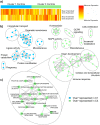Large scale aggregate microarray analysis reveals three distinct molecular subclasses of human preeclampsia
- PMID: 25679511
- PMCID: PMC4332506
- DOI: 10.1371/journal.pone.0116508
Large scale aggregate microarray analysis reveals three distinct molecular subclasses of human preeclampsia
Abstract
Background: Preeclampsia (PE) is a life-threatening hypertensive pathology of pregnancy affecting 3-5% of all pregnancies. To date, PE has no cure, early detection markers, or effective treatments short of the removal of what is thought to be the causative organ, the placenta, which may necessitate a preterm delivery. Additionally, numerous small placental microarray studies attempting to identify "PE-specific" genes have yielded inconsistent results. We therefore hypothesize that preeclampsia is a multifactorial disease encompassing several pathology subclasses, and that large cohort placental gene expression analysis will reveal these groups.
Results: To address our hypothesis, we utilized known bioinformatic methods to aggregate 7 microarray data sets across multiple platforms in order to generate a large data set of 173 patient samples, including 77 with preeclampsia. Unsupervised clustering of these patient samples revealed three distinct molecular subclasses of PE. This included a "canonical" PE subclass demonstrating elevated expression of known PE markers and genes associated with poor oxygenation and increased secretion, as well as two other subclasses potentially representing a poor maternal response to pregnancy and an immunological presentation of preeclampsia.
Conclusion: Our analysis sheds new light on the heterogeneity of PE patients, and offers up additional avenues for future investigation. Hopefully, our subclassification of preeclampsia based on molecular diversity will finally lead to the development of robust diagnostics and patient-based treatments for this disorder.
Conflict of interest statement
Figures





Similar articles
-
Unsupervised Placental Gene Expression Profiling Identifies Clinically Relevant Subclasses of Human Preeclampsia.Hypertension. 2016 Jul;68(1):137-47. doi: 10.1161/HYPERTENSIONAHA.116.07293. Epub 2016 May 9. Hypertension. 2016. PMID: 27160201
-
Epigenetic regulation of placental gene expression in transcriptional subtypes of preeclampsia.Clin Epigenetics. 2018 Mar 2;10:28. doi: 10.1186/s13148-018-0463-6. eCollection 2018. Clin Epigenetics. 2018. PMID: 29507646 Free PMC article.
-
The clinical heterogeneity of preeclampsia is related to both placental gene expression and placental histopathology.Am J Obstet Gynecol. 2018 Dec;219(6):604.e1-604.e25. doi: 10.1016/j.ajog.2018.09.036. Epub 2018 Sep 29. Am J Obstet Gynecol. 2018. PMID: 30278173
-
Novel biomarkers in preeclampsia.Clin Chim Acta. 2006 Feb;364(1-2):22-32. doi: 10.1016/j.cca.2005.06.011. Epub 2005 Sep 1. Clin Chim Acta. 2006. PMID: 16139262 Review.
-
Meta-analysis of gene expression profiles in preeclampsia.Pregnancy Hypertens. 2020 Jan;19:52-60. doi: 10.1016/j.preghy.2019.12.007. Epub 2019 Dec 20. Pregnancy Hypertens. 2020. PMID: 31901653
Cited by
-
Arginine vasopressin infusion is sufficient to model clinical features of preeclampsia in mice.JCI Insight. 2018 Oct 4;3(19):e99403. doi: 10.1172/jci.insight.99403. JCI Insight. 2018. PMID: 30282823 Free PMC article.
-
Human Leukocyte Antigens in Pregnancy and Preeclampsia.Front Genet. 2022 Apr 27;13:884275. doi: 10.3389/fgene.2022.884275. eCollection 2022. Front Genet. 2022. PMID: 35571013 Free PMC article. Review.
-
A comparison of rat models that best mimic immune-driven preeclampsia in humans.Front Endocrinol (Lausanne). 2023 Sep 28;14:1219205. doi: 10.3389/fendo.2023.1219205. eCollection 2023. Front Endocrinol (Lausanne). 2023. PMID: 37842294 Free PMC article.
-
Medawar's PostEra: Galectins Emerged as Key Players During Fetal-Maternal Glycoimmune Adaptation.Front Immunol. 2021 Dec 15;12:784473. doi: 10.3389/fimmu.2021.784473. eCollection 2021. Front Immunol. 2021. PMID: 34975875 Free PMC article. Review.
-
Manipulating CD4+ T Cell Pathways to Prevent Preeclampsia.Front Bioeng Biotechnol. 2022 Jan 12;9:811417. doi: 10.3389/fbioe.2021.811417. eCollection 2021. Front Bioeng Biotechnol. 2022. PMID: 35096797 Free PMC article. Review.
References
-
- Kleinrouweler CE, Wiegerinck MMJ, Ris-Stalpers C, Bossuyt PMM, van der Post J a M, et al. (2012) Accuracy of circulating placental growth factor, vascular endothelial growth factor, soluble fms-like tyrosine kinase 1 and soluble endoglin in the prediction of pre-eclampsia: a systematic review and meta-analysis. BJOG 119: 778–787. 10.1111/j.1471-0528.2012.03311.x - DOI - PubMed
Publication types
MeSH terms
Substances
Grants and funding
LinkOut - more resources
Full Text Sources
Other Literature Sources

